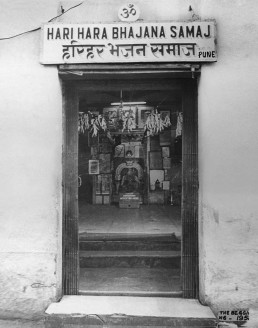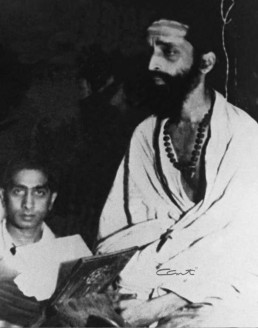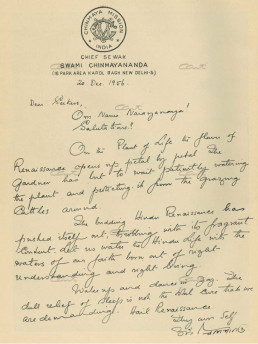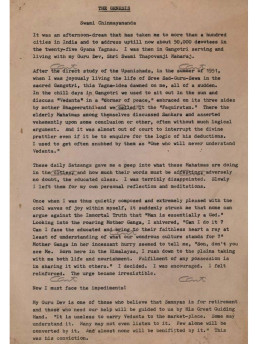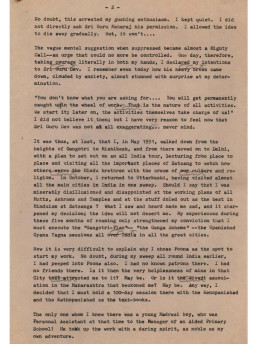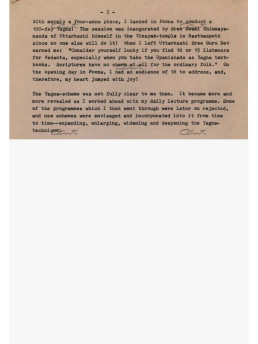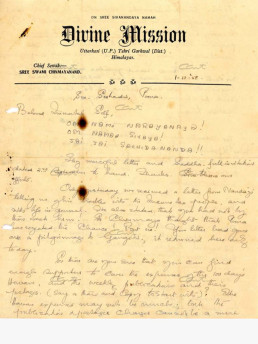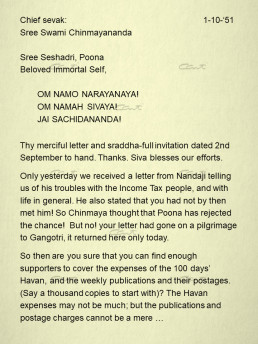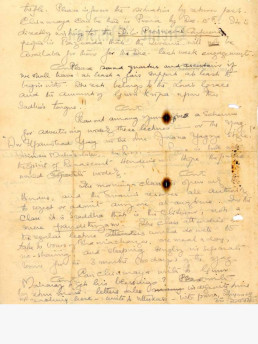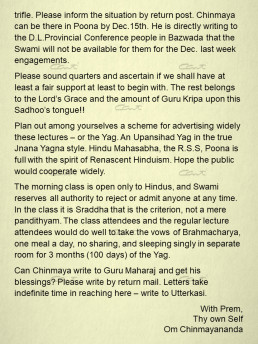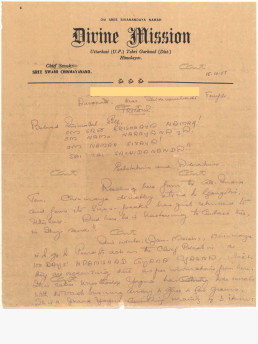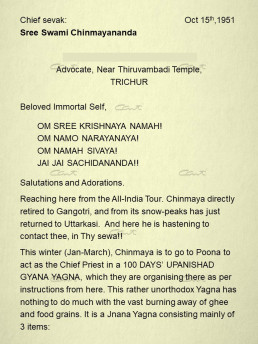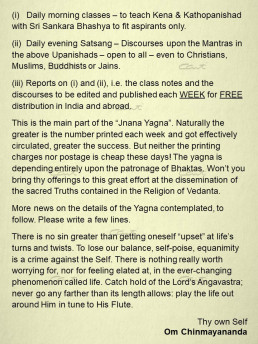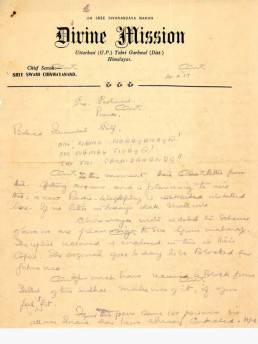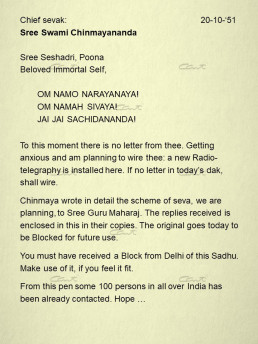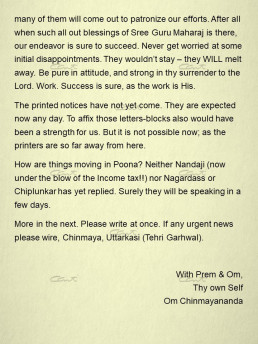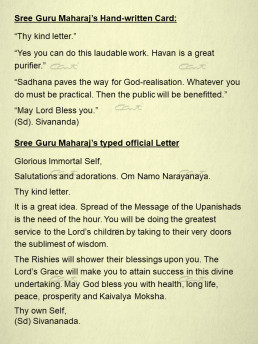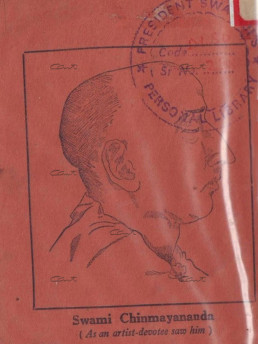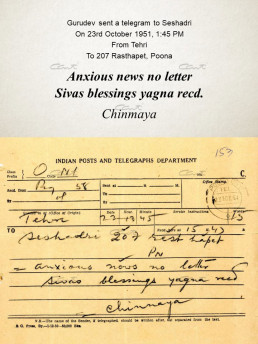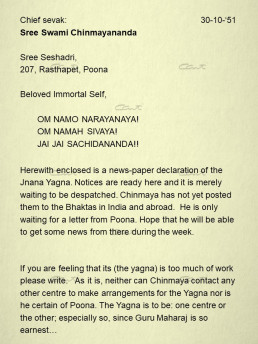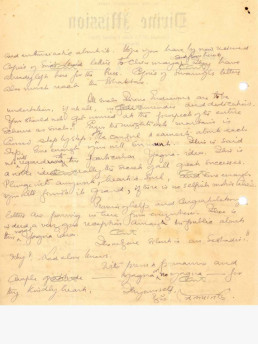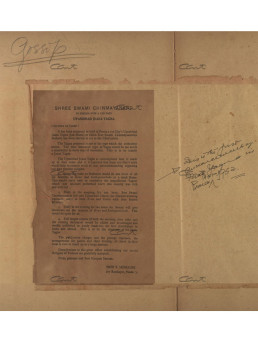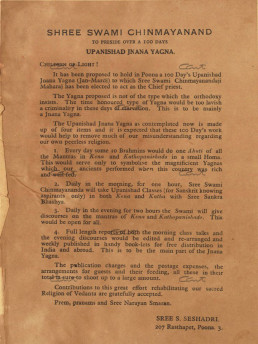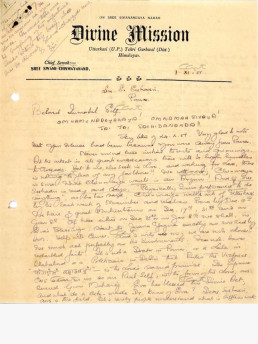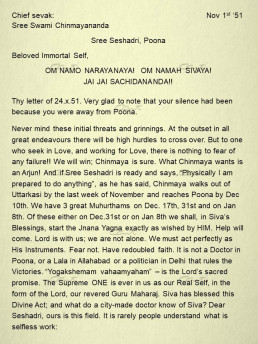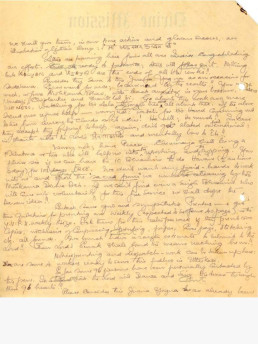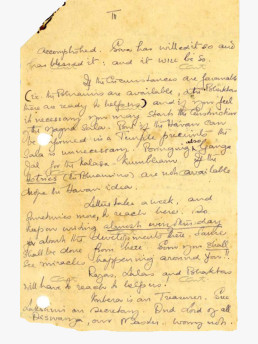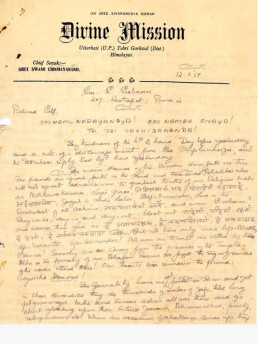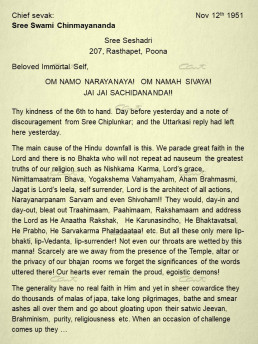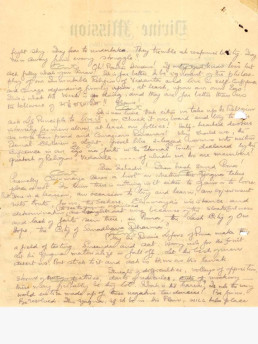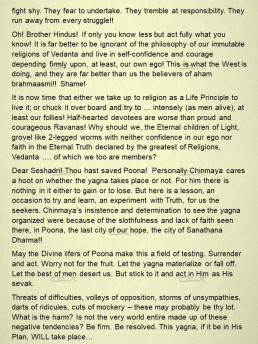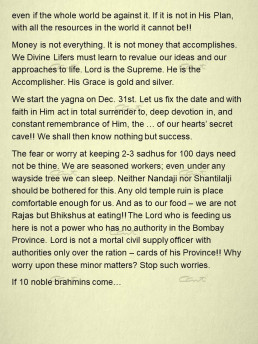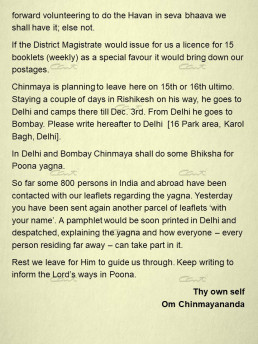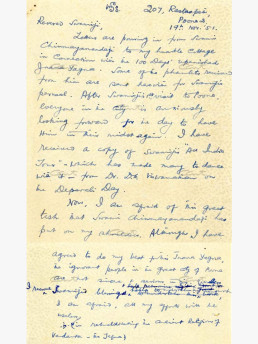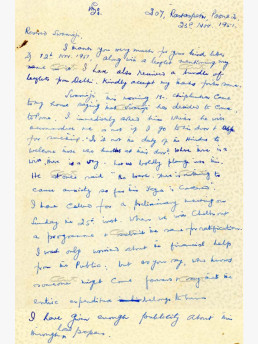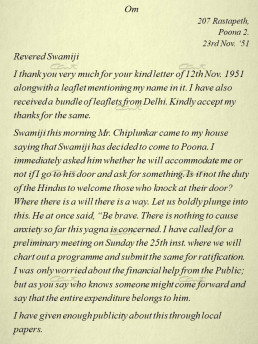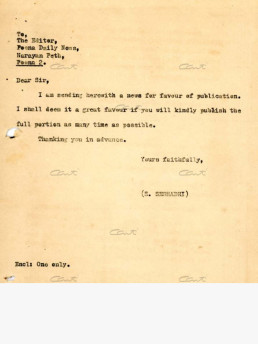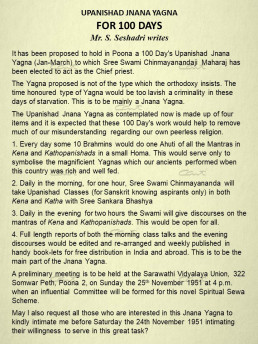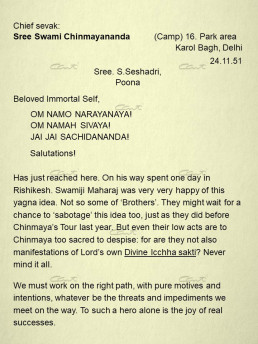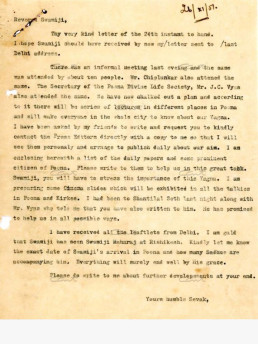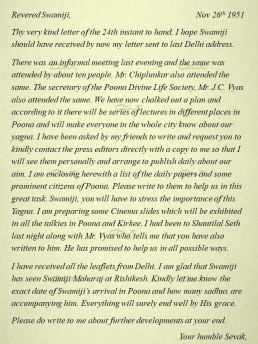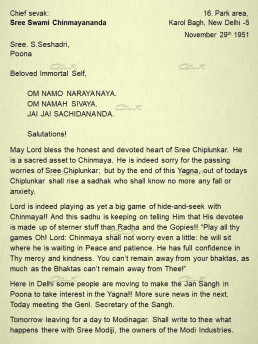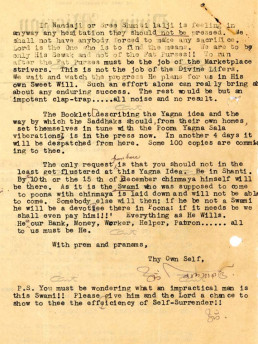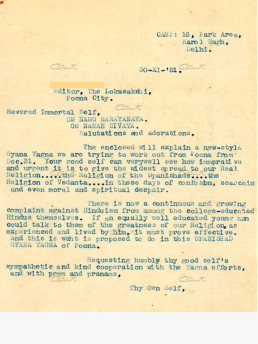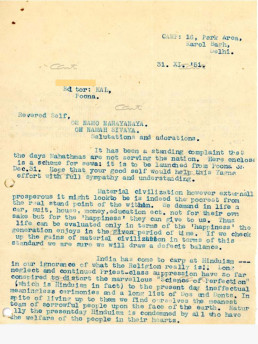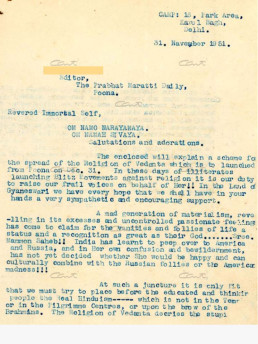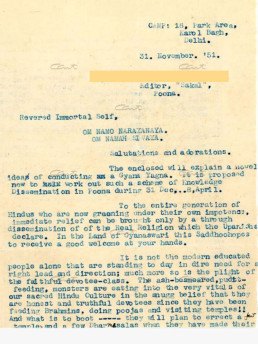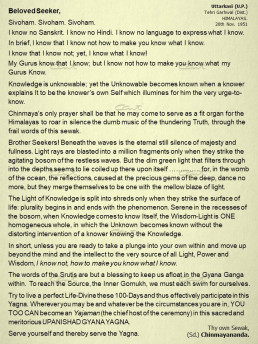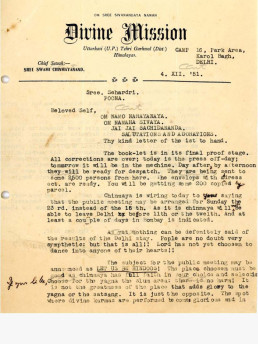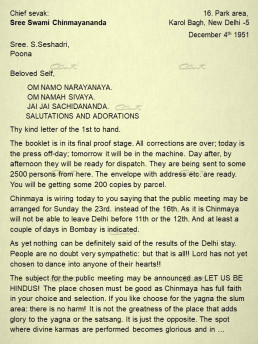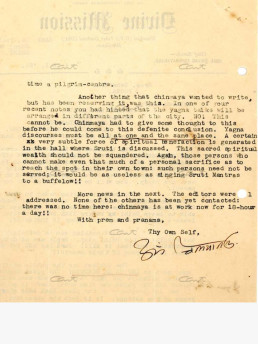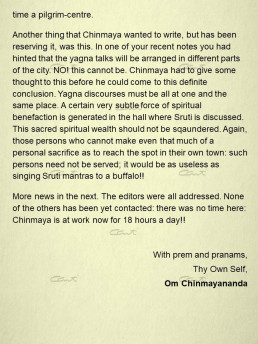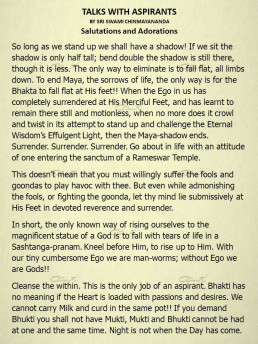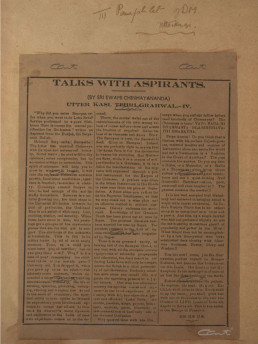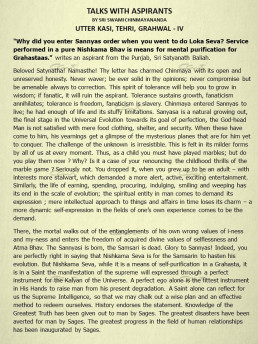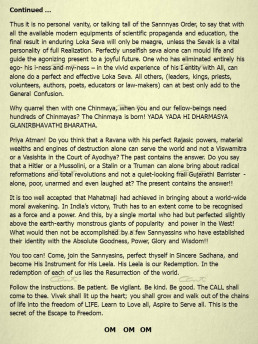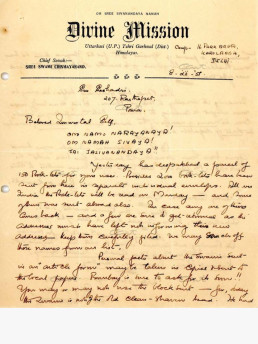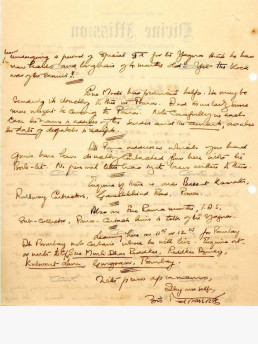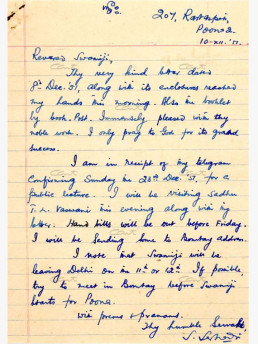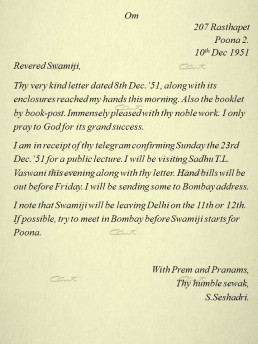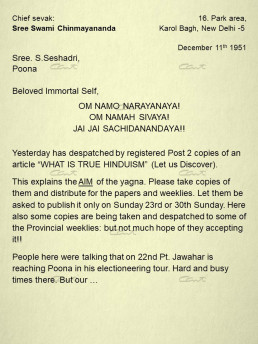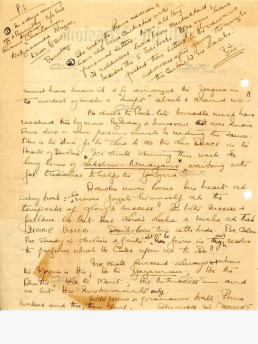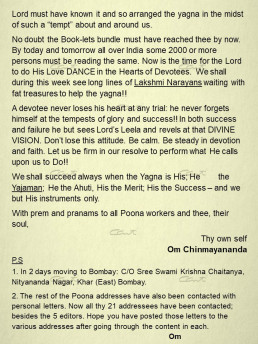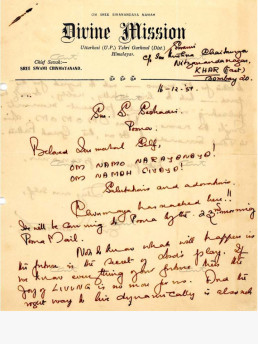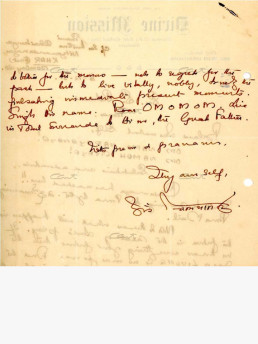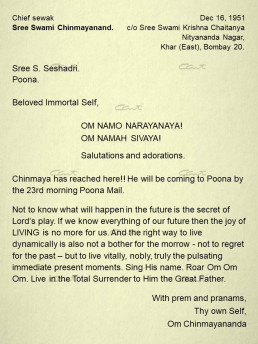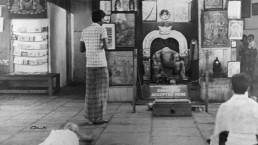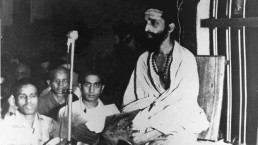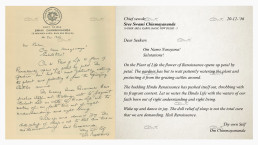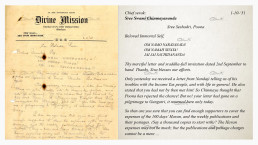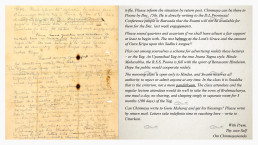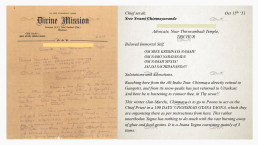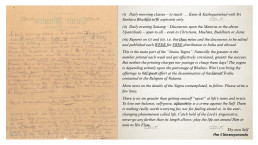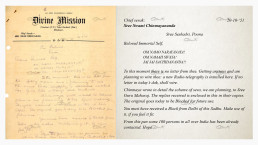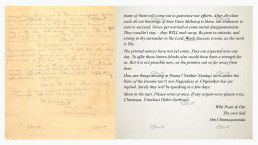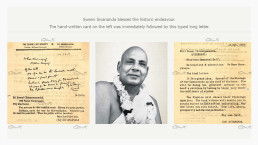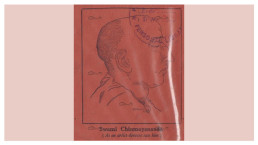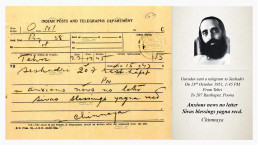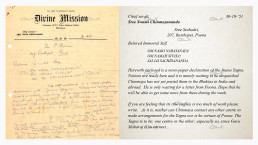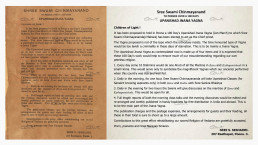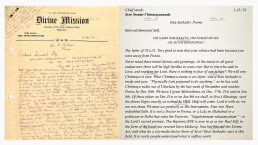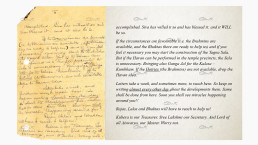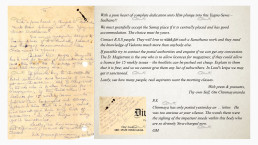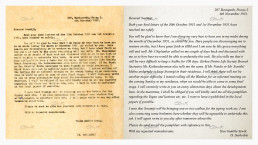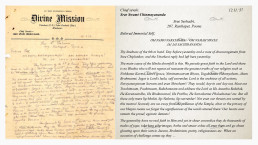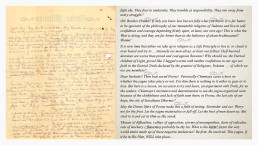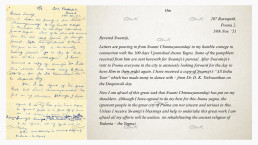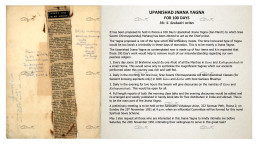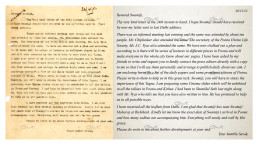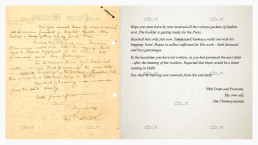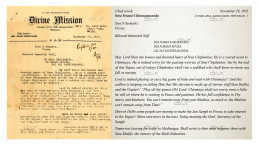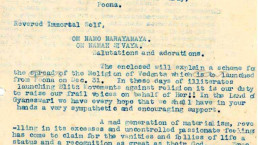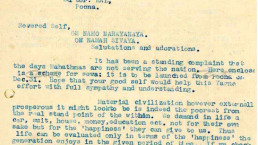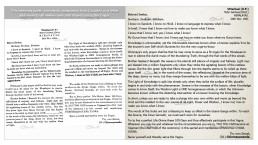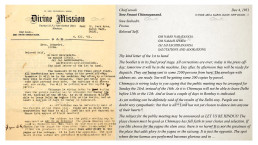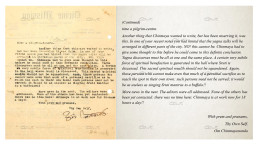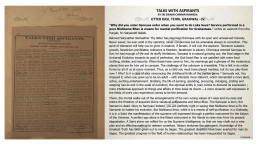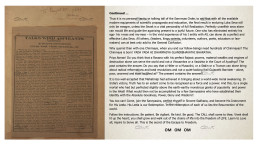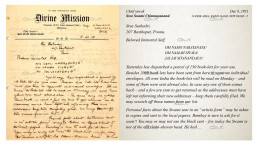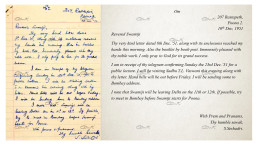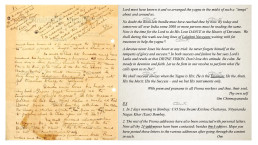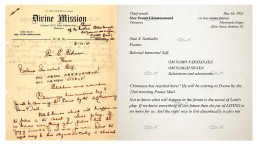This video describes the fascinating effort of a young Swami Chinmayananda in the year 1951, to launch the Jnana Yajna program, with the help of a young Madrasi boy from Pune. For detailed information on this story, please continue to scroll below.
INTRODUCTION
Encouraging the brahmacharis entering the field of prachar work to spread the message of our scriptures, Pujya Gurudev would say, “In my first jnana yajna in Poona, there were only four people, including the speaker!” No one knew at that time how much effort and preparation had gone into the organization of the first yajna in the Ganesh Temple in Rasthapeth, Pune. It was only when Swamini Kaivalyananda unearthed the letters to Sri Seshadri, who helped in organizing that first yajna, that the micro details behind that historic event tumbled out.
THE GENESIS: IN HIS OWN WORDS

A souvenir named “Hail Renaissance” was released to mark the 25th jnana yajna in Hyderabad, held from December 16, 1956 to January 5, 1957. There, Pujya Gurudev wrote about the story of the birth and growth of the jnana yajna in an article titled “The Genesis”. This gives us very important information about how it all happened in his own words.
THE PLANS CRYSTALLIZE
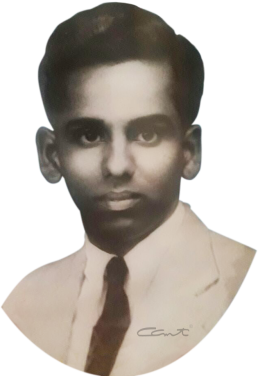
Pujya Gurudev had gone on an All India Tour from December 1950 to April 1951, at which time he had visited Pune and met Seshadri, “the young Madrasi boy” he mentions in The Genesis. Having already obtained the permission of his Guru Swami Tapovan Maharaj, he proceeded to plan the first jnana yajna in Pune. In a letter dated October 1, 1951, written from Uttarkashi, he follows up his discussions with Seshadri regarding the finances and publicity of the yajna. He has also taken into account the cost of converting the talks into small booklets and posting them to people, showing meticulous planning and an eye for details.
THE PLAN PROGRESSES
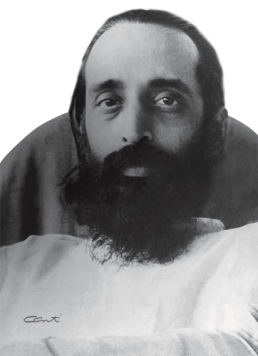
From Uttarkashi to Pune was a long distance in those days when letters travelled by snail mail, taking anywhere from ten days to a month to reach. If there was a landslide or some other natural disaster, the letter might never reach its destination. Pujya Gurudev functioned under these difficult circumstances. He wrote to Swami Sivananda about his plans and received his blessings for this historic endeavour. He arranged for printed notices and sent a block of his own image to Seshadri for printing. He wrote personal letters to 100 people enlisting their support.
INSPIRING THE WORKER
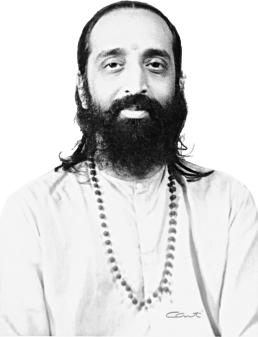
Letters were too slow to keep pace with the amazing speed of the Swami at work. A new telegraph office had opened in Uttarkashi and he sent a telegram to Seshadri from there. He had published a notice about the yajna in a newspaper and had the pamphlets with details of the yajna program, all ready to be posted. And yet, no news from Seshadri about the progress of the arrangements in Pune! So he wrote on October 30, 1951, inspiring him to march ahead: “Even the mightiest mountain is crossed step by step; only be careful and earnest about each step.”
INAUGURAL DATE FOR THE YAJNA
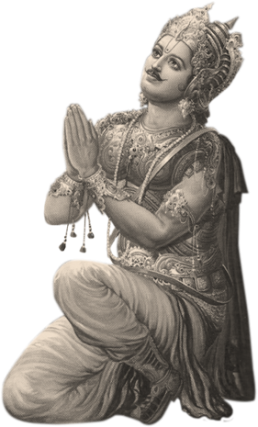
At last Seshadri’s reply reached the Swami. Immediately he wrote back, appreciating the devotee’s commitment to do anything: “What Chinmaya wants is an Arjun!” He suggested three dates for the inauguration of the yajna. The letter spills over with his boundless enthusiasm and positive energy, his immense self-confidence and total surrender to God’s Will, his utter faith in the words of the Guru and his blessings. “Kubera is our Treasurer. Sree Lakshmi our Secretary. And Lord of all Aiswarya, our Master. Worry not.” At the same time, he does not lose sight of the details and gives a volley of instructions to Seshadri.
MISGIVINGS GALORE: GURUDEV'S RESPONSE
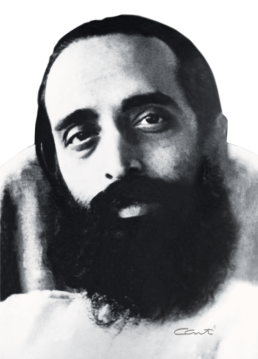
Seshadri must have wondered what he had let himself in for! He voiced his misgivings: “Here people are discouraging me to venture on this …” People had said, “It will be very difficult to keep a Sadhu for 100 days.” Gurudev wrote back, lashing at the sheer cowardice of Hindus who pay only lip service to religion. “We are seasoned workers … Any old temple ruin is place comfortable enough for us. And as to our food – we are not Rajas, but Bhikshus at eating!!” Dismissing his worries and brushing aside all the difficulties, he asserts, “Money is not everything … His Grace is gold and silver.” By that time, he had contacted 800 persons already, in India and abroad. “Be resolved. This yagna, if it be in His plan, WILL take place even if the whole world be against it.”
COMMITTEE MEETING IN PUNE
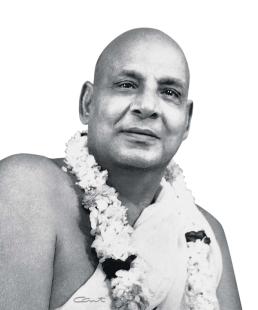
Seshadri seems to have been so rattled at what he had taken on that he wrote to Swami Sivananda, “Now I am afraid of this great task that Swami Chinmayanandaji has put on my shoulders.” However, with Gurudev’s replies, he rallied round and called for a meeting in Pune on November 25, 1951. Stirred into activity, he started writing to the editors of the local papers about the jnana yajna. He also prepared some ‘cinema slides’ to be exhibited in the ‘talkies’ (cinema halls) in Pune.
GATHERING MOMENTUM

By November 24, Pujya Gurudev had reached Delhi and was personally contacting people for support. A new hurdle was that the swami with shorthand and typing skills who was to accompany him to Pune became sick and opted out. Gurudev wrote to Seshadri, “Someone else will (come) then … Everything as He Wills. He is our Bank, Money, Worker, Helper, Patron … all to us must be He.” He also wrote personal letters to the editors of Pune newspapers – The Lokashakti, Poona Daily News, Kal, The Prabhat Marathi Daily, Sakal – each one different and personalized. And he sent an article about himself to Seshadri, “The press is generally curious and thirsty for personal news. Enclosed is an article …”
BOOKLET FOR SEEKERS

Pujya Gurudev had prepared a detailed booklet to guide the participants in the jnana yajna – how they had to live a disciplined life, following a sattvic pattern of life, observing brahmacharya, moderation in food, purity of thoughts and so on. These will be taken up in detail in our next update about the first yajna. However, we present here an intensely poetic and mystic outpouring, an open letter addressed to all seekers, written on November 20, 1951, which was published in this booklet. This booklet was sent to 2,500 persons from Delhi.
PUBLIC TALKS: RUN UP TO THE YAJNA

On December 4, 1951, Gurudev wrote to Seshadri that he would arrive in Pune on the 20th and to arrange the public meeting on the 23rd on the topic “Let us be Hindus”. He rejected Seshadri’s suggestion that the yajna talks may be spread over different venues: “A certain very subtle force of spiritual benefaction is generated in the hall where Sruti is discussed.” He also sent a beautiful and inspiring article titled “Talks with Aspirants” for the press and another one titled “What is True Hinduism” to explain the aim of the yajna. Other letters followed, giving instructions about many details. “We shall succeed always when the Yagna is His; He is the Yajaman; He the Ahuti; His the merit; His the success – and we but His instruments only.”
ARRIVES FOR THE YAJNA IN PUNE

Gurudev reached Bombay and wrote to Seshadri on December 16, to say that he would reach Pune on the 23rd. On the 19th, with barely ten days to go for the yajna, Seshadri wrote to him, “I have not yet succeeded in getting a place for performing this Yagna.” Everything was set for the yajna, except the venue!! However, we do not have any more letters after this to tell us how it was settled finally. “I am sure everything will end well by the grace of God,” wrote Seshadri calmly. He had learnt a lesson or two in this whole process! Here ends the story of how Gurudev organized the first jnana yajna with the help of a sole “Madrasi boy” in Pune.
INTRODUCTION
Encouraging the brahmacharis entering the field of prachar work to spread the message of our scriptures, Pujya Gurudev would say, “In my first jnana yajna in Poona, there were only four people, including the speaker!” No one knew at that time how much effort and preparation had gone into the organization of the first yajna in the Ganesh Temple in Rasthapeth, Pune. It was only when Swamini Kaivalyananda unearthed the letters to Sri Seshadri, who helped in organizing that first yajna, that the micro details behind that historic event tumbled out.
THE GENESIS: IN HIS OWN WORDS
A souvenir named “Hail Renaissance” was released to mark the 25th jnana yajna in Hyderabad, held from December 16, 1956 to January 5, 1957. There, Pujya Gurudev wrote about the story of the birth and growth of the jnana yajna in an article titled “The Genesis”. This gives us very important information about how it all happened in his own words.
THE PLANS CRYSTALLIZE
Pujya Gurudev had gone on an All India Tour from December 1950 to April 1951, at which time he had visited Pune and met Seshadri, “the young Madrasi boy” he mentions in The Genesis. Having already obtained the permission of his Guru Swami Tapovan Maharaj, he proceeded to plan the first jnana yajna in Pune. In a letter dated October 1, 1951, written from Uttarkashi, he follows up his discussions with Seshadri regarding the finances and publicity of the yajna. He has also taken into account the cost of converting the talks into small booklets and posting them to people, showing meticulous planning and an eye for details.
THE PLAN PROGRESSES
From Uttarkashi to Pune was a long distance in those days when letters travelled by snail mail, taking anywhere from ten days to a month to reach. If there was a landslide or some other natural disaster, the letter might never reach its destination. Pujya Gurudev functioned under these difficult circumstances. He wrote to Swami Sivananda about his plans and received his blessings for this historic endeavour. He arranged for printed notices and sent a block of his own image to Seshadri for printing. He wrote personal letters to 100 people enlisting their support.
INSPIRING THE WORKER
Letters were too slow to keep pace with the amazing speed of the Swami at work. A new telegraph office had opened in Uttarkashi and he sent a telegram to Seshadri from there. He had published a notice about the yajna in a newspaper and had the pamphlets with details of the yajna program, all ready to be posted. And yet, no news from Seshadri about the progress of the arrangements in Pune! So he wrote on October 30, 1951, inspiring him to march ahead: “Even the mightiest mountain is crossed step by step; only be careful and earnest about each step.”
Inaugural Date for the Yajna
At last Seshadri’s reply reached the Swami. Immediately he wrote back, appreciating the devotee’s commitment to do anything: “What Chinmaya wants is an Arjun!” He suggested three dates for the inauguration of the yajna. The letter spills over with his boundless enthusiasm and positive energy, his immense self-confidence and total surrender to God’s Will, his utter faith in the words of the Guru and his blessings. “Kubera is our Treasurer. Sree Lakshmi our Secretary. And Lord of all Aiswarya, our Master. Worry not.” At the same time, he does not lose sight of the details and gives a volley of instructions to Seshadri.
Misgivings Galore: Gurudev’s Response
Seshadri must have wondered what he had let himself in for! He voiced his misgivings: “Here people are discouraging me to venture on this …” People had said, “It will be very difficult to keep a Sadhu for 100 days.” Gurudev wrote back, lashing at the sheer cowardice of Hindus who pay only lip service to religion. “We are seasoned workers … Any old temple ruin is place comfortable enough for us. And as to our food – we are not Rajas, but Bhikshus at eating!!” Dismissing his worries and brushing aside all the difficulties, he asserts, “Money is not everything … His Grace is gold and silver.” By that time, he had contacted 800 persons already, in India and abroad. “Be resolved. This yagna, if it be in His plan, WILL take place even if the whole world be against it.”
Committee Meeting in Pune
Seshadri seems to have been so rattled at what he had taken on that he wrote to Swami Sivananda, “Now I am afraid of this great task that Swami Chinmayanandaji has put on my shoulders.” However, with Gurudev’s replies, he rallied round and called for a meeting in Pune on November 25, 1951. Stirred into activity, he started writing to the editors of the local papers about the jnana yajna. He also prepared some ‘cinema slides’ to be exhibited in the ‘talkies’ (cinema halls) in Pune.
Gathering Momentum
By November 24, Pujya Gurudev had reached Delhi and was personally contacting people for support. A new hurdle was that the swami with shorthand and typing skills who was to accompany him to Pune became sick and opted out. Gurudev wrote to Seshadri, “Someone else will (come) then … Everything as He Wills. He is our Bank, Money, Worker, Helper, Patron … all to us must be He.” He also wrote personal letters to the editors of Pune newspapers – The Lokashakti, Poona Daily News, Kal, The Prabhat Marathi Daily, Sakal – each one different and personalized. And he sent an article about himself to Seshadri, “The press is generally curious and thirsty for personal news. Enclosed is an article …”
BOOKLET FOR SEEKERS
Pujya Gurudev had prepared a detailed booklet to guide the participants in the jnana yajna – how they had to live a disciplined life, following a sattvic pattern of life, observing brahmacharya, moderation in food, purity of thoughts and so on. These will be taken up in detail in our next update about the first yajna. However, we present here an intensely poetic and mystic outpouring, an open letter addressed to all seekers, written on November 20, 1951, which was published in this booklet. This booklet was sent to 2,500 persons from Delhi.
Public Talks: Run Up to the Yajna
On December 4, 1951, Gurudev wrote to Seshadri that he would arrive in Pune on the 20th and to arrange the public meeting on the 23rd on the topic “Let us be Hindus”. He rejected Seshadri’s suggestion that the yajna talks may be spread over different venues: “A certain very subtle force of spiritual benefaction is generated in the hall where Sruti is discussed.” He also sent a beautiful and inspiring article titled “Talks with Aspirants” for the press and another one titled “What is True Hinduism” to explain the aim of the yajna. Other letters followed, giving instructions about many details. “We shall succeed always when the Yagna is His; He is the Yajaman; He the Ahuti; His the merit; His the success – and we but His instruments only.”
Arrives For the Yajna in Pune
Gurudev reached Bombay and wrote to Seshadri on December 16, to say that he would reach Pune on the 23rd. On the 19th, with barely ten days to go for the yajna, Seshadri wrote to him, “I have not yet succeeded in getting a place for performing this Yagna.” Everything was set for the yajna, except the venue!! However, we do not have any more letters after this to tell us how it was settled finally. “I am sure everything will end well by the grace of God,” wrote Seshadri calmly. He had learnt a lesson or two in this whole process! Here ends the story of how Gurudev organized the first jnana yajna with the help of a sole “Madrasi boy” in Pune.
